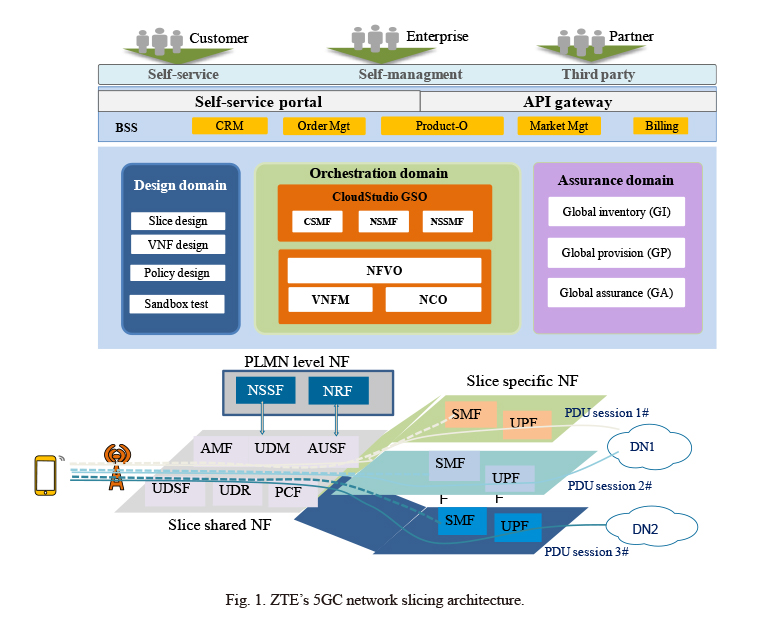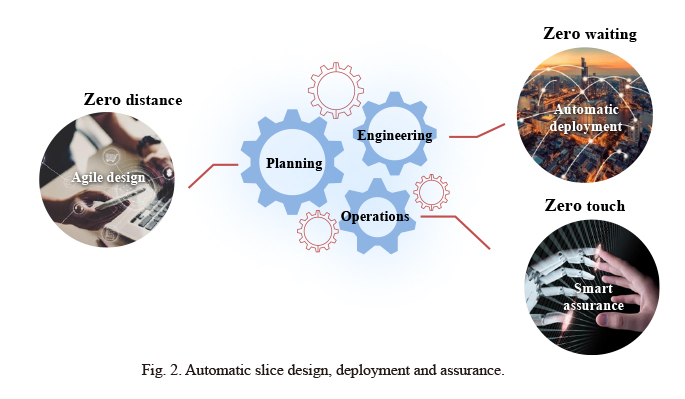Innovative 5GC Slicing Solution Activates New Business Models
Scenarios of 5G Slicing
5G empowers various vertical industrial applications, while each 5G service has a great different requirement on latency, bandwidth, and the number of connections. Therefore 5G defines three typical scenarios: eMBB, uRLLC, and mMTC.
●eMBB: VR/AR, HD video, and 3D applications requiring peak data rates of more than 10 Gbps
●uRLLC: industrial control, e-health, remote monitoring, and IoV applications placing high requirements on E2E latency (less than 5 ms), security and reliability (above 99.999%)
●mMTC: smart home, smart city, environmental monitoring, intelligent agriculture and other IoT services requiring low power consumption and massive connections (more than 1M connections per km2 ).
In the 5G era, a single physical network cannot meet SLA requirements of the above-mentioned vertical industries. The need for personalized and differentiated services gives rise to 5G network slicing.
ZTE’s 5GC Slicing Solution
ZTE’s 5GC slicing solution provides standard and open interfaces, supporting DevOps-based automatic and intelligent network slice design, orchestration and assurance. It also provides a full set of 5GC network elements such as AMF, SMF, UPF, NSSF, NRF, PCF, UDM, NEF, and NWDAF, supporting the construction, subscription and selection of all kinds of slices (Fig. 1).
The 5GC slicing solution allows customers, enterprises or partners to subscribe online slices through the self-service portal or API gateway and submit relative SLA requirements to the Communication Service Management Function (CSMF), including online user number, average data rate, latency, security isolation, service type, cost , coverage area, etc. The CSMF converts them into slice SLA requirements and triggers NSMF and NSSMF to perform automatic orchestration and deployment of slices and sub-slices.

Key 5GC Slicing Technologies
ZTE’s 5GC slicing solution supports cloud native and service-based slicing, allowing for automatic slice design, orchestration and deployment as well as intelligent slice selection.
Service-Based Slicing
ZTE adopts microservice architecture to split services for 5GC network functions (NFs). The microservice architecture supports 3GPP-defined network function services (NFSs) and provides enhanced public services such as cloud database (CDB), load balancer (LB), and virtual router (VR). According to slice SLA requirements, appropriate NFSs can be selected and combined into NFs necessary for various slices such as UPF_eMBB, UPF_uRLLC and UPF_mMTC, and the NFs are then combined into the corresponding network slices.
Intelligent Slice Selection
ZTE has actively proposed the deployment of network slice selection function (NSSF) in 3GPP and its proposals have been accepted. NSSF intelligently selects slices based on the network slice selection assistance information (NSSAI) requested and subscribed by a user, user location, slice capacity, and current slice load. The intelligent slice selection is also based on the slice related performance data obtained by NWDAF and on the AI technology.
Network slice selection policy (NSSP) is set through the policy control function (PCF) and is sent to the user equipment (UE), in which the mapping relationship of APP and slice is defined, such as IMS APP→eMBB.
Automatic Slice Design, Deployment and Assurance
ZTE’s 5GC Slicing solution adopts visual design, automatic deployment, intelligent operations for rapid slice design, deployment and assurance (Fig. 2).

●Zero distance: agile design, zero distance between the demand and design, drag-and-drop visual design based on template modification to enable what you see is what you get (WYSIWYG)
●Zero waiting: automatic service provisioning, zero waiting from design to deployment, buy & play service, full automation from slice subscription, orchestration, deployment to activation
●Zero touch: intelligent assurance, zero touch operations, intelligent and automatic slice operations based on automatic closed-loop assurance, route cause analysis, and the AI technology.
Layered Slice Isolation
ZTE’s 5GC slicing solution provides multi-layer security isolation covering the NFVI, VNF and management layers. At the NFVI layer, the solution provides high security isolation based on independent hardware as well as virtual resource isolation based on NFVI tenants. At the VNF application layer, it supports logic isolation. At the management layer, it provides failure, configuration, accounting, performance and security (FCAPS) isolation for different tenants based on the slice ID.
Suggestions for 5G Slicing Division and Deployment
5G slices can be divided by industry, region, and virtual operator to meet specific needs of different industries and regions. Thus differentiated slices can be provided.
●Division by industry: As different vertical industries raise different SLA requirements on slices, different slices can be divided for a specific industry. For example, there are eMBB slices available for the VR/AR and HD video industry, mMTC slices for the industry of smart city and intelligent agriculture, and uRLLC slices for self-driving and telemedicine. According to service requirements, a slice can be subdivided into several subslices such as eMBB_vr/ar and eMBB_3D, and slices can also be combined into one slice such as eMBB/uRLLC for high-bandwidth and low-latency V2X service.
●Division by region: Based on the large slice covering province, city or country, an operator can build hot slices or microslices for different regions such as industrial parks, business centers, and stadiums. When a UE enters the region, it prefers to access the slice of this region. When the UE leaves this region, it will access a large slice.
●Division by virtual operator: Different slices are built for different virtual operators to guarantee that each operator can operate independently and develop its new business model.
Business Models of 5G Slicing
ZTE has actively cooperated with vertical industries and operators on network slicing that involves smart grid, industrial control and drone, promoting the commercial slice deployment. Its E2E slicing solution supports not only B2C slice service but also network slice as a service (NSaaS), offering wholesale and online sale of slices such as slice stores and slice markets. The solution also provides new B2B and B2B2C business models for operators. Operators can sale slices to enterprises or wholesale the slices to their partners, and the partners then retail the slices to different enterprise users. In this way, a new 5G business ecosystem can be established.